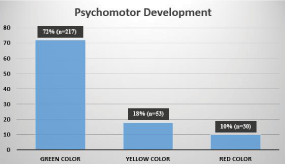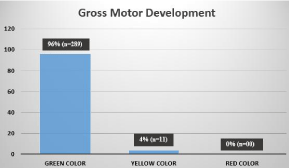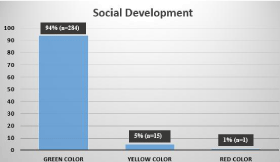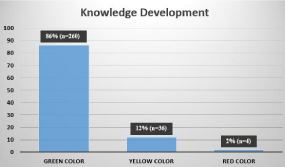Abstract
Background: The estimated prevalence of alterations in psychomotor development is 12-16% in industrialized countries. In Mexico, the prevalence of the specific disorder of psychomotor development is unknown. The modern family is where the mother works in the same conditions as the father or where the mother works to support the family. Traditional family is when the father is the only provider of sustenance for the family and the mother is dedicated to the home and children. The association between family type and alterations in psychomotor development is unknown.
Aim: The purpose of this study is to determine the association between traditional family and child development in Tijuana, Mexico.
Design and Setting: Comparative cross-sectional study.
Methods: In 300 patients in the Family Medicine Unit #27, Tijuana, Baja California, family typology and psychomotor development were measured to make an association between them. The following variables were collected: age, sex, schooling and age of mothers and psychomotor development. For statistical analysis, association was established with odds ratio and chi-squared test with 95% interval confidence (p<0.05).
Results: Of the 300 children, 72.3% presented a normal development (green color), 17.7% development lag (yellow color) and 10% with risk of delay (red color). The association between family typology and psychomotor development showed the following results: [OR=1.2, 95% CI (0.7-2.0), p >0.05], this association had not statistically significant differences.
Conclusion: A high frequency of patients with alterations in psychomotor development was found and there was no association with their family typology.
Keywords: Psychomotor development; Traditional Family; Modern Family
Introduction
Care during childhood should promote the proper development of children integrally, the ideal place to care for and monitor growth and development is the first level of health care [1]. Development is a dynamic process that indicates change, differentiation, maturation, and transformation to complex levels of organization, in aspects such as biological, psychological, cognitive, nutritional, ethical, sexual, etiological, cultural and social [2]. Neurodevelopment occurs through a dynamic process of interaction between the child and the environment, as a result, they get the maturation of the nervous system with development of brain functions and the formation of personality [3].
The problems in development, according to the American Academy of Pediatrics, are defined as all those chronic, early onset symptoms that have in common difficulty in the acquisition of motor, language, social or cognitive skills that cause a significant impact on progress of a child's development. They are presented if there is failure in achieving the expected behaviors for the age. Although some developmental problems may be transient, delays at an early age may be associated with later disabilities such as mental retardation, cerebral palsy, autism, language disorders and other learning problems [4]. In Mexico, seven screening tests have been identified for alterations in child development; The Child Development Assessment (EDI) scale is the scale with the lowest risk of bias in the published data with a sensitivity of 81% and specificity of 61%. [5-6].
The family is the most important part of individual and social development, has as a fundamental duty the protection of each member and allow their growth. For the World Health Organization, "The family is the basic unit of social organization and also the most accessible for preventive and therapeutic interventions. The health of the family goes beyond the physical and mental conditions of its members; it provides a social environment for the natural development and personal fulfillment of all those who are part of it” [7]. The modern family has elements of development that raise the idea of it in higah s osocicailo secchoenmome tioc lwevheiclsh. iItt rreepferress etnot st haen dfa wmei lfyr einqu wenhtilcyh fi tnhde mother works in the same conditions as the father or the one without a father where the mother works to support the family. The traditional family is represented by middle and lower class families, they are the most numerous. Their main characteristic is the transmission of sociocultural models and the social values perpetuation of these characteristics through the development of new families. It is one in which the father is the only provider of sustenance for the family and the mother is dedicated to the home and to the children [8].
Families perform essential functions, such as socialization and care, which are essential for people to obtain well-being. Families continue to be a fundamental part to enable the attainment of well-being, so changes in its structure and functioning are studied throughout the world, mainly in Latin America, where these transformations are occurring in an accelerated manner, as a consequence of several demographic factors, economic and cultural [9]. An increasing number of children grow up in non-traditional families and this has provoked a strong debate regarding the suitability of different family structures for child development. The experts position in relation to this issue has changed from an initial position where the traditional family was considered the most capable of guaranteeing adequate child development, to the current position where different types of families have seen as appropriate as the traditional model, demonstrating that they are capable of satisfying the needs of the children living in them. Based on the above, the main objective of this research is to determine the association between traditional family and child development in Tijuana, Mexico.
Materials and Methods
A comparative cross-sectional study was carried out in the Family Medicine Unit #27 (FMU-27), of the Instituto Mexicano del Seguro Social (IMSS), located in Tijuana, Baja California, Mexico, in children that met the following inclusion criteria: age between 49-60 months, that accepted and signed the informed consent by parents and informed consent of the children; children with alterations of development or chronic diseases already diagnosed were not included and eliminated those who did not complete the evaluation of development.
The following data were obtained directly from the participants, parents or medical records: age, sex, age of mothers, schooling of mothers, family typology according development and evaluation of psychomotor development. The procedure for the data collection was as follows: age was calculated in months according to the year and month of birth, sex was determined according to phenotypic characteristics of each patient, age and schooling of mothers was determined by asking directly, typology was evaluated according development and classified in tradition or modern families. The evaluation of psychomotor development was calculated according to Child Development Assessment test, a screening tool designed and validated in Mexico for the early detection of neurodevelopmental problems in children under 5 years of age.
There are two modalities of application of the items in EDI test: 1) Directed questions: where the item is investigated by questioning the mother, the father or caregiver; 2) Observation of the child: The item is investigated by examining the child's behavior. The evaluator will find two asterisks (**) in the items that require evaluation of the child. The 5 axes that the EDI test evaluates are gross motor, fine motor, language, social and knowledge. Each item of the EDI test is scored individually, following a very simple format with only two possible answers: Does it or has it (YES), or Does not or does not have it (NO), also verifies the frequency of the appearance of behavior based on two responses: it always or most of the time (YES), or it does not or very rarely (NO). At the end of the test, based on the results obtained in the five axes, the development of the child can be qualified as: 1) Normal development (green color) where the child meets the milestones and skills expected for their age group in all areas of development and also does not present any alarm signal or abnormal data in the neurological examination; 2) Lag in development (yellow color) where the child does not meet the milestones and skills expected for their age group but does not present a significant delay because they have achieved the milestones of the previous age group and 3) Risk of developmental delay (red color) where the child does not adequately meet the milestones of development and skills expected for his age group and presents a considerable delay in the previous group, or shows signs of high risk, or an abnormality clear in the neurological examination [10]. With the obtained qualification, the yellow and red result are considered positive, although a different intervention is proposed for each one, since each one allows to identify different magnitude of the alterations in the development and support differentiated interventions [11].
The recollected data was integrated into data collection sheets and analyzed using the SPSS program version 20 in Spanish, where we applied descriptive statistics; for qualitative variables, frequencies and percentages were used and for quantitative variables, mean and standard deviation were used. For the bivariate analysis, odds ratio and Ji-Square test was used to determinate association and statistically significant differences between the groups. The Kolmogorov-Smirnoff test was used to establish the normality of the data. It was considered a p<0.05 as statistically significant, with a 95% confidence interval. The Protocol was authorized by the Local Committee of Research and Ethics in Health Research from the Family Medicine Unit #27, where this study took place.
Results
We analyzed a sample of 300 patients, the age distribution was from 49 to 60 months, with a mean of 52 ± 3.5 months. In sex, there was an equality distribution with 55% (n=165) women and 45% (n=135) men. The mothers of the children included in the study had the following age distribution: 0.35% (n= 1) are younger than 19 years old, 69.7% (n= 209) 20-30 years old and 30% (n= 90) are over 30 years old. In schooling, 9% (n= 27) finished primary, 62% (n= 186) secondary, 22.3% (n= 67) high school and 6.7% (n= 20) college. The distribution of family typology was 50% (n=150) traditional families and 50% (n=150) modern families.
Of the 300 children, 72.3% (n= 217) presented a normal development (green color), 17.7% (n= 53) development lag (yellow color) and 10% (n= 30) with risk of delay (red color) (Graphic 1). The percentage by sex of the child development reported: 71% (n= 91) in green, 16.3% (n= 22) in yellow and 12.6% (n= 17) in red for the male gender; in women, 73.3% (n= 121) in green, 18.8% (n= 31) in yellow and 7.9% (n= 30) in red. Within the area of gross motor development of the EDI test (Graphic 2), 96.3% (n= 289) children had a green color score, 3.7% (n= 11) yellow color and no risk of delay was found in this area of development. In the area of fine motor development (Graphic 3), 87.7% (n= 263) had green color, 10.7% (n= 32) yellow and 1.7% (n= 5) red color. In the area of language development (Graphic 4), 94.3% (n= 283) had green color, 5% (n= 15) yellow color and 0.7% (n= 2) red color. In the area of social development (Graphic 5), 94.7% (n= 284) green color, 5% (n= 15) in yellow color and 0.3% (n= 1) in red color. In the area of knowledge development (Graphic 6), it was found that 86.7% (n= 260) had a rating in green, 12% (n= 36) in yellow and 1.3% (n= 4) in red. For bivariate analysis we make an association psychomotor development and family typology (Table 1); the association between this variables showed the following result: [OR=1.2, 95% CI (0.7-2.0), p >0.05]; this association had not statistically significant differences.
Development alterations (n=83)
Normal development
(n=217)
Family typology
N
%
N
%
OR
95% CI
p
Traditional family
45
54
105
48
1.2
0.7-2.0
>0.05
Modern Family
38
46
112
52
%= Percentage, n= Frequency, p= Ji-Square, CI= confidence interval.
Table 1: Association between family typology and psychomotor development.

Figure 1: Descriptive analysis of the distribution by psychomotor
development.

Figure 2: Descriptive analysis of the distribution by gross motor
development.

Figure 3: Descriptive analysis of the distribution by fine motor development.

Figure 4: Descriptive analysis of the distribution by language development.

Figure 5: Descriptive analysis of the distribution by social development.

Figure 6: Descriptive analysis of the distribution by knowledge development.
Discussion and Conclusion
The prevalence of alterations in child development in children under 5 years of age was 27.7%. In the present study, the area of child development mostly affected is knowledge with 13.3%. When using the test for the evaluation of child development, it was found that the prevalence found is similar to that reported by Tirado-Callejas [12], in a study carried out in Querétaro where the prevalence of alteration of the child development in children under 5 years was 26.46%. In the United States of America a prevalence of 12-16% is reported according to the American Academy of Pediatrics [13].
The most frequent sociodemographic characteristics in mothers are similar to those found in other international studies such as Martínez-Pérez [14] where women are described between 20-30 years. When making the association between family typology and alterations in child development, it shows us that the traditional family, unlike what was thought and expected at the beginning of the research, is a risk factor for the alteration of child development in any of their areas, however this result was not statistically significant. It is childhood where there are greater opportunities for development and learning. A very important role is attributed to the mother as part of the social education system, a low maternal education and poor educational quality in home could be related as risk factors for alterations in child development, especially in social areas and language, since these are very susceptible to environmental influence. The study can open new lines of research to detect factors associated with the psychomotor development of children and intervene in a timely manner in their growth.
References
- Control y seguimiento de la salud en la niña y el niño menor de 5 años en el primer nivel de atención. Guía de práctica clínica, México: Secretaría de Salud; 2008.
- Detección del Trastorno Especifico del Desarrollo Psicomotor en niños de 0 a 3 años. Guía de práctica clínica, México: Secretaría de Salud; 2014.
- Medina Alva MDP, Caro-Kahn I, Muñoz Huerta P, Leyva Sánchez J, Moreno Calixto J, Vega Sánchez SM. Neurodesarrollo infantil: características normales y signos de alarma en el niño menor de cinco años. Rev Peru Med Exp Salud Pública. 2015; 32: 565-573.
- Gonzalez-Cardona S, Castaño-Castrillon JJ, Galeano-Ramirez J, Gomez-Ospina DC, Gonzalez Henao NA, GuzmanRodriguez MA, et al. Principales hallazgos en el programa de crecimiento y desarrollo de los niños hasta los 60 meses de edad en ASSBASALUD ESE. Arch Med. 2011; 11: 127-139.
- Orcajo-Castelan R, Sidonio-Aguayo B, Alcacio-Mendoza J, Lopez-Diaz G. Análisis comparativo de pruebas de tamiz para la detección de problemas en el desarrollo diseñadas y validadas en México. Bol Med Hosp Infant Mex. 2015; 72: 367-375.
- Rizzoli-Córdoba A, Schnaas-Y-Arrieta L, Ortega-Riosvelasco F, Rodríguez-Ortega E, Villasís-Keever MA, Aceves-Villagrán D, et al. Child Development Evaluation Test analysis by field improves detection of developmental problems in children. Bol Med Hosp Infant Mex. 2014; 71: 154-162.
- Suarez-Cuba MA. El médico familiar y la atención a la familia. Rev Paceña Med Fam. 2006; 3: 95-100.
- Membrillo Luna A, Fernández Ortega MA, Quiroz Pérez JR, Rodríguez López JL. Familia, introducción al estudio de sus elementos. 1ra ed. México D. F.: ETM; 2008.
- Ullmann H, Maldonado Valera C, Nieves Rico M. La evolución de las estructuras familiares en América Latina, 1990-2010: Los retos de la pobreza, la vulnerabilidad y el cuidado. UNICEF: CEPAL; 2014.
- Manual para la Aplicación de la Prueba Evaluación del Desarrollo Infantil EDI. México, D.F.: Secretaria de Salud; 2013.
- Rizzoli-Cordoba A, Ortega-Riosvelasco F, Villasis-Keever MA, Pizarro-Castellanos M, Buenrostro-Marquez G, Aceves-Villagran D, et al. Reliability for detection of developmental problems using the semaphore from the Child Development Evaluation test: Is a yellow result different from a red result? Bol Med Hosp Infant Mex. 2014; 71: 277-285.
- Tirado-Callejas KB. Prevalencias de alteraciones en el desarrollo psicomotor para niños de 1 mes a 5 años valorados con la prueba EDI en un centro de salud en México en el periodo febrero a noviembre de 2015. European Scientific Journal. 2017; 13: 1857: 7881.
- American Academy of Pediatrics. Developmental Surveillance and Screening of Infants and Young Children. 2001; 108.
- Martínez-Bordón A, Soto de la Rosa H. Programas para el cuidado y el desarrollo infantil temprano en los países del sistema de la integración centroamericana (SICA). Comisión Económica para América Latina y el Caribe: Naciones Unidas; 2012.
